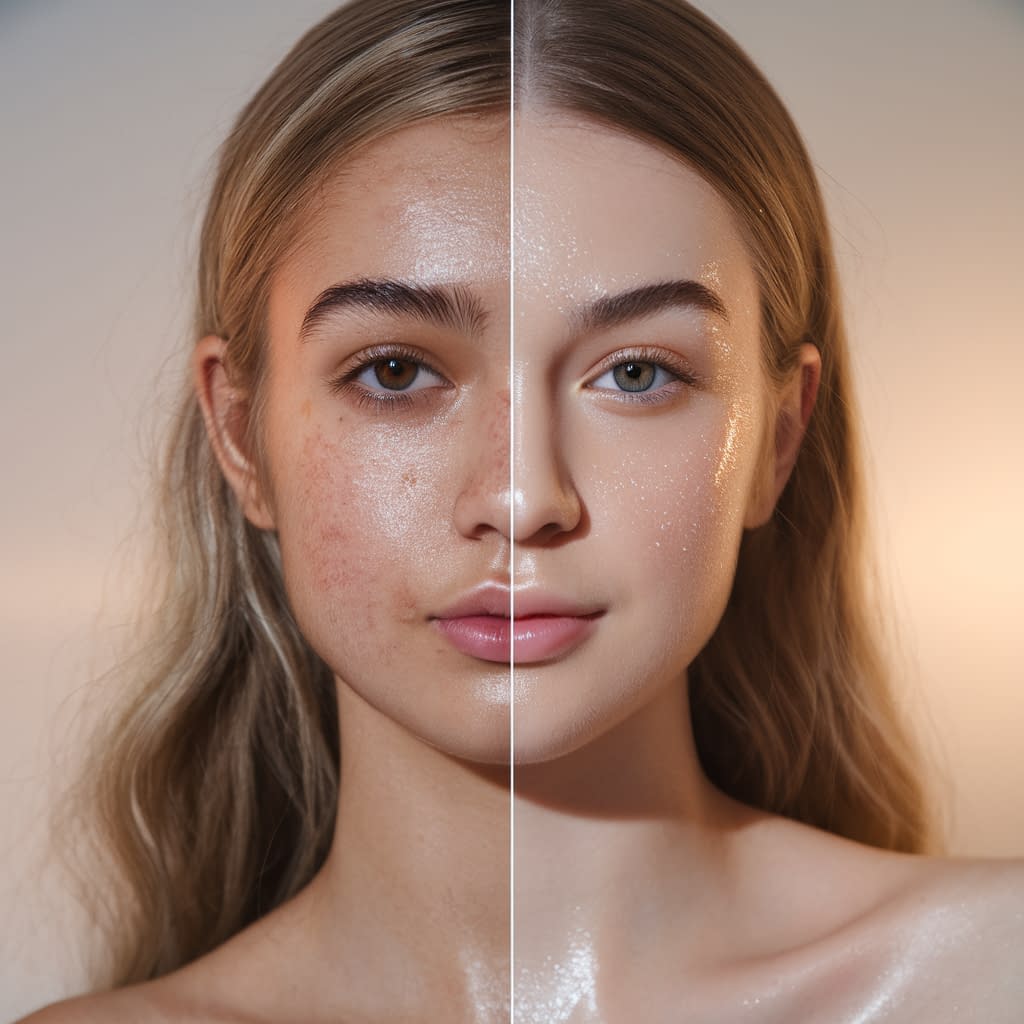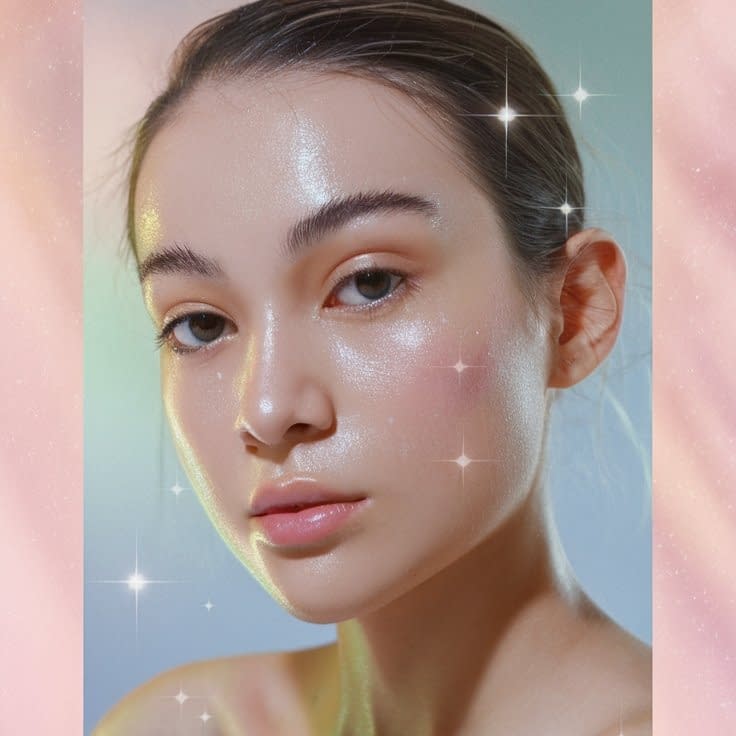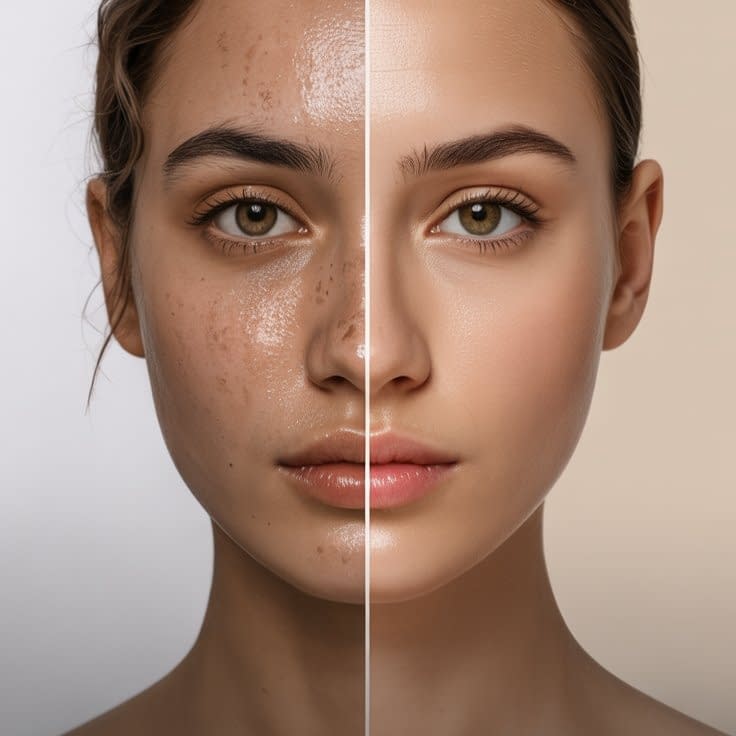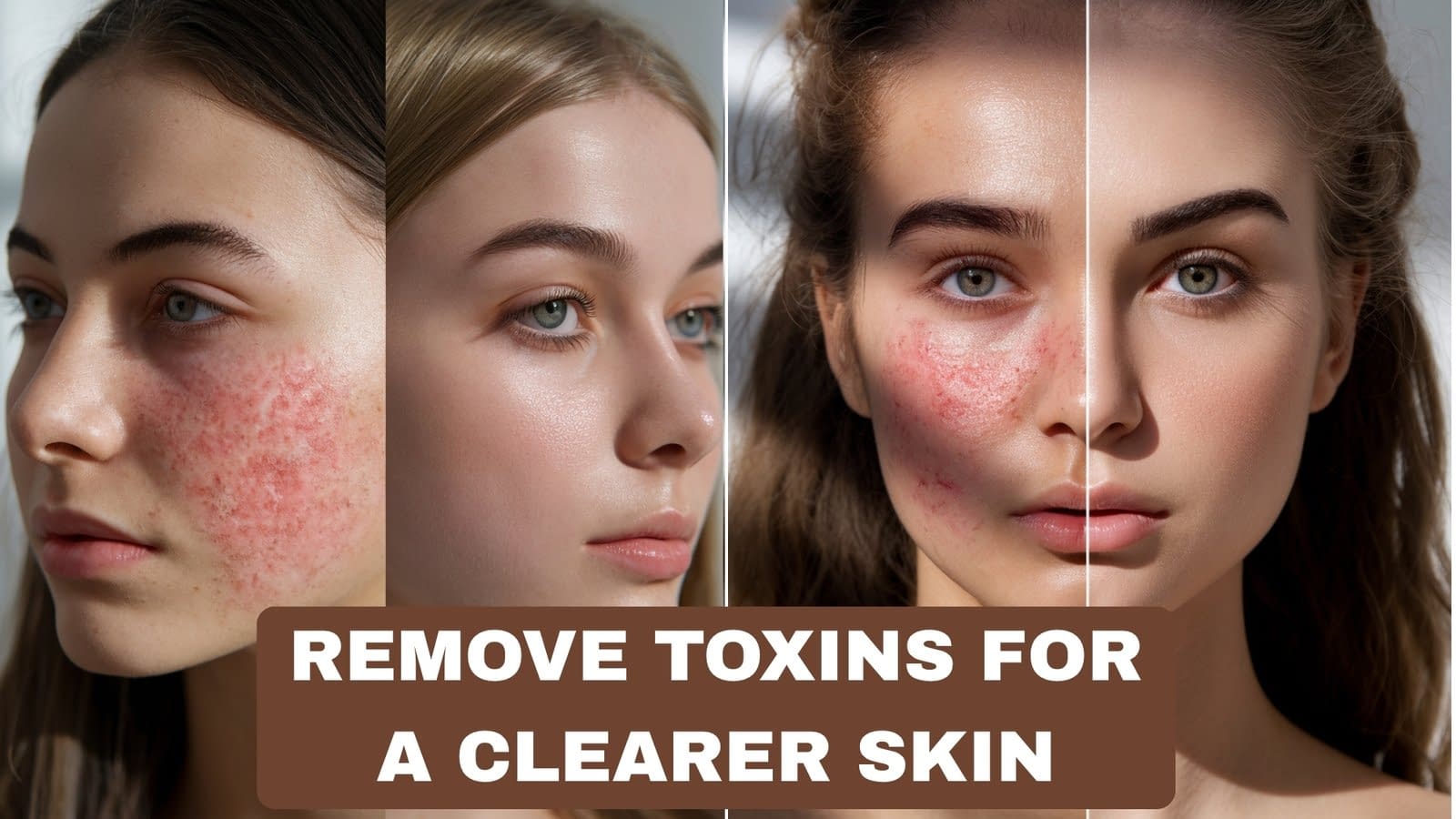Clear, luminous, almost translucent-looking skin — the “glass skin” trend from Korean beauty routines — isn’t about filters or makeup. It’s about healthy, hydrated skin with smooth texture, minimal visible pores, and a reflective, even surface. This guide breaks the concept down into practical steps you can actually use at home, focusing on gentle, natural ingredients and daily habits that support long-term skin health. No miracle hacks — just repeatable habits.
What Is “Glass Skin”? The Korean Beauty Secret Explained

Short answer: Glass skin describes skin that looks smooth, even-toned, ultra-hydrated and luminous — almost reflective like glass. It’s a look that emphasizes clarity and a dewy finish rather than heavy coverage.
Origins & why it’s popular:
- The term arose from Korean beauty (K-beauty) culture, which prioritizes care-first routines: prevention, gentle ingredients, and multi-step regimens focused on hydration and barrier support.
- Social media amplified the aesthetic because it’s visually striking and signals skin health (good hydration + low inflammation). It looks “real” — skin that’s cared-for rather than covered up.
What glass skin is not:
- It’s not grease or shine from clogged pores.
- It’s not the same as oiliness or glossy makeup.
- It isn’t achieved with harsh stripping or extreme exfoliation — those damage the barrier and make skin worse.
Bottom line: Glass skin = healthy barrier + consistent hydration + smooth texture + minimal inflammation.
The Core Principles Behind a Glass Skin Routine
To aim for that glassy finish, focus on three foundational pillars:
1) Hydration (inside and out)
- Skin needs water in the epidermis layer to look plump and smooth. Hydrating ingredients (hyaluronic acid, glycerin, aloe) hold moisture in; occlusives (shea, squalane) prevent evaporation.
- Hydration is not only moisturizer — it’s also drinking water and eating water-rich foods.
2) Layering (smart, not excessive)
- K-beauty routines layer lightweight, water-based products (toner / essence / serum) before heavier creams to build hydration and deliver active ingredients without overload.
- Layering helps the skin absorb more while maintaining balance.
3) Barrier health & low inflammation
- A healthy skin barrier locks moisture, defends against irritants, and calms redness. Repair it with ceramides, niacinamide, gentle oils and minimal harsh surfactants.
- Less inflammation = fewer reactive marks, better tone, and a smoother surface.
Supporting pillars (must-haves)
- Gentle exfoliation (chemical AHA/BHA 1×–2× weekly) to smooth texture and unclog pores.
- Sun protection every day — UV is the top disruptor of texture and tone.
- Consistency & patience — these changes take weeks to months.
Step-by-Step Guide: Your Daily Glass Skin Routine

Below are simple, reproducible morning and nighttime routines using accessible, gentle products or natural alternatives. Think consistency over complexity.
Morning routine (5–7 minutes)
- Cleanse (gentle)
- Use a mild, low-foam cleanser or splash with lukewarm water if your skin is dry. Goal: remove sleep oils and impurities without stripping.
- Natural option: a gentle milk cleanser with a tiny amount of honey whisked in.
- Hydrating toner / essence
- Pat on a hydrating toner or essence (look for “hydrating” or “moisture” on label; contains glycerin, hyaluronic acid or aloe). Apply while skin is slightly damp to lock water in.
- Light serum (antioxidant / hydrating)
- Vitamin C (morning) for antioxidant protection and brightening; or a hyaluronic acid serum for extra plumpness.
- Natural option: a few drops of pure aloe + a tiny pinch of powdered vitamin C mixed fresh (patch test first).
- Moisturizer
- Lightweight gel-cream if oily; richer cream if dry. Choose barrier-supporting ingredients: ceramides, glycerin, squalane.
- Sunscreen (every day)
- Broad-spectrum SPF 30+ applied as the last step. Reapply if outdoors for long periods.
- Optional: facial mist
- Midday spritz of rosewater or thermal water to refresh and boost surface hydration.
Evening routine (8–12 minutes)
- Double cleanse if wearing makeup/sunscreen
- Oil or balm cleanser first to dissolve makeup and sunscreen, followed by a gentle water-based cleanser.
- Hydrating toner / essence
- Same as morning — immediately on damp skin.
- Targeted serum
- Niacinamide for barrier support and pore appearance; or a retinol/retinoid (start low frequency) if addressing texture and fine lines. Use retinoids only at night and skip when pregnant/breastfeeding unless cleared by your doctor.
- Moisturizer / sleeping mask
- Seal with a cream that contains humectants + occlusives (e.g., glycerin + squalane). Once or twice weekly, substitute a sleeping mask for an intensive overnight boost.
- Optional: eye cream
- Gentle hydrating eye cream if needed.
Weekly extras (1–2× per week)
- Chemical exfoliant (low % AHA or BHA): improves texture, helps serums absorb. Start once per week.
- Hydrating sheet mask: 15–20 minutes on damp skin after toner for instant plumpness.
- Gentle clay mask (if oily): pick kaolin for gentle oil control, rinse quickly.
Step-by-step routine example for sensitive skin
- AM: rinse, aloe toner (pat), niacinamide 2–5% serum, light cream with ceramides, SPF 30.
- PM: oil cleanse (if worn SPF), gentle cream cleanser, hyaluronic essence, low-dose retinol 1–2× weekly (if tolerable), ceramide-rich cream.
(If retinol causes irritation, stop and consult a dermatologist.)
Natural Ingredients That Help You Achieve Glass Skin
Many natural ingredients provide hydration, antioxidants, or barrier support. Use them carefully (patch-test) and ideally in formulations that preserve potency.
High-impact natural ingredients
- Aloe vera — soothing, hydrating, good as a lightweight toner or mixed with a humectant.
- Green tea — antioxidant, calming; works in toners or masks; optional brew as a compress.
- Honey (raw / manuka) — humectant and mild antimicrobial; great in short masks (5–15 minutes). Avoid leaving sticky honey on for extended periods if you’re acne-prone.
- Rice water — rich in vitamins and gentle starches; traditionally used to brighten and soothe. Can be used as a toner or rinse (see DIY below).
- Centella asiatica (cica) — popular in K-beauty for barrier repair and calming irritated skin.
- Oat (colloidal oatmeal) — barrier-soothing, reduces redness and itch. Good in cleansers or rinses.
Humectants & barrier helpers (naturally derived)
- Glycerin — powerful humectant; draws moisture to the skin.
- Squalane (plant-derived) — light emollient that supports the barrier and adds slip for a dreamy finish.
- Natural oils for sealing: jojoba, almond, rosehip — use sparingly and patch-test (some people break out from heavy oils).
Note: “Natural” ≠ automatically safe for everyone; essential oils and concentrated plant extracts can irritate. Patch-test anything new.
DIY Home Remedies for a Dewy, Smooth Complexion
Use these gentle, simple at-home recipes 1–2× weekly. Keep them short in contact time (5–20 minutes depending on recipe) and patch-test.
1) Hydrating rice water toner (gentle brightening)
- Make: Rinse ½ cup rice, then soak in 1 cup water for 30 minutes. Strain liquid into a clean jar. Refrigerate up to 3 days.
- Use: After cleansing, apply with a cotton pad or spray bottle as toner. Pat in; follow with serum/moisturizer.
- Why: Contains B vitamins and starches that can temporarily soften the skin and improve texture.
2) Soothing green tea + honey mist (antioxidant + hydration)
- Make: Brew 1 green tea bag in 1 cup hot water, cool. Mix 1–2 tsp raw honey into cooled tea until dissolved. Pour into a spray bottle.
- Use: Mist lightly over face after cleansing or during a sheet mask step. Store refrigerated up to 5 days.
- Why: Antioxidants + gentle humectant action.
3) Overnight aloe + glycerin hydration patch
- Make: Mix 1 tbsp pure aloe gel + 1 tsp vegetable glycerin.
- Use: Apply thinly to dry areas (cheeks, forehead) at night; wash off in morning. Not for oily, acne-prone faces unless patch-tested—glycerin can feel sticky but attracts moisture.
4) Gentle oatmeal soothing mask (for redness/sensitivity)
- Make: 2 tbsp finely ground oats + enough warm water to make a paste. Optionally add 1 tsp honey.
- Use: Apply for 8–10 minutes, rinse with cool water. Great for calming and softening.
5) Light exfoliation — yogurt + honey (lactic acid)
- Make: 1 tbsp plain yogurt + 1 tsp honey.
- Use: Apply for 5–8 minutes and rinse. Lactic acid in yogurt gently exfoliates and hydrates. Don’t combine with other strong actives the same day.
Safety note: Avoid DIY masks with abrasive physical scrubs if you have inflamed acne or rosacea. Keep DIY frequency low (1–2× weekly).
Foods and Drinks That Nourish Your Skin From Within

Glass skin depends on internal health. Aim for an anti-inflammatory, hydration-focused diet.
Eat more of:
- Water-rich fruits & veggies: cucumbers, watermelon, oranges, tomatoes, leafy greens. They hydrate and provide vitamin C.
- Omega-3 sources: salmon, mackerel, chia, walnuts — reduce inflammation and support barrier lipids.
- Colorful berries & citrus: vitamin C and polyphenols help collagen synthesis and antioxidant defense.
- Cruciferous vegetables: broccoli, Brussels sprouts — support liver pathways that process environmental compounds.
- Fermented foods: yogurt, kefir, kimchi (if tolerated) — support the gut-skin axis.
Drink:
- Water consistently (spread intake across day).
- Green tea — polyphenols and catechins with antioxidant benefits.
- Limit alcohol & excess caffeine — both can dehydrate and disturb sleep.
Simple daily meal template to support skin:
- Breakfast: Greek yogurt + berries + ground flax.
- Lunch: Mixed green salad, quinoa, roasted salmon/tuna or chickpeas.
- Snack: Carrot sticks + hummus or an orange.
- Dinner: Stir-fry with colorful vegetables and lean protein, side of brown rice.
- Drinks: water + 1–2 cups green tea.
Common Mistakes That Prevent You From Getting Glass Skin
Avoid these frequent slip-ups — they undermine even the best routines.
1) Over-exfoliating
- Problem: Microtears, barrier damage, redness, sensitivity and more oil production.
- Fix: Limit to 1–2× weekly chemical exfoliation (low % AHA/BHA) and skip aggressive scrubs.
2) Skipping sunscreen
- Problem: UV accelerates texture damage, pigment, and dullness.
- Fix: Apply broad-spectrum SPF 30+ every morning and reapply when needed.
3) Using too many actives at once
- Problem: Layering retinol + acids + strong vitamin C can create irritation.
- Fix: Introduce one active at a time; use retinoids at night, vitamin C in AM, acids 1× weekly initially.
4) Neglecting the skin barrier
- Problem: Stripping cleansers and high alcohol toners remove lipids and increase TEWL (water loss).
- Fix: Use gentle cleansers, include ceramides and oils, and hydrate before sealing.
5) Expecting immediate results
- Problem: Skin turnover and collagen remodeling take weeks–months.
- Fix: Track progress for 6–12 weeks and adjust gently.
6) Overreliance on topical “detox” products
- Problem: Quick-fix masks or overnight cleanses won’t fix systemic causes and can irritate.
- Fix: Pair topical care with diet, sleep and sun protection.
Simple Lifestyle Habits for Long-Lasting Glow
These daily habits are the scaffolding that make any routine work.
Sleep & repair
- Aim for 7–9 hours nightly. The body does most cell repair during deep sleep; collagen pathways are active during rest.
Stress management
- Chronic stress raises cortisol and inflammation. 10–20 minutes/day of breathing, walking, or mindfulness reduces flare-ups.
Movement & circulation
- Regular exercise promotes blood flow, lymphatic drainage, and sweat-based surface cleansing.
Environmental awareness
- Reduce indoor pollutants: ventilate rooms, avoid heavy indoor smoke, wash pillowcases weekly (oil/dust build-up).
Hydration & moderate alcohol
- Sip water throughout the day. Cut back on alcohol at nights when you want your skin at its best.
Final Tips: Maintaining That Effortless Glass Skin Glow
Be consistent, not extreme. A gentle routine performed daily beats aggressive routines done sporadically.
Patch-test new ingredients. Especially with DIYs or plant extracts.
Keep a simple active rotation. Example: Vitamin C AM, retinol PM (alternate nights when starting), exfoliate 1× week, niacinamide nightly for barrier support.
Adapt seasonally. Add richer creams in winter, lighter gels in summer. Still keep sunscreen.
Don’t forget the small things. Clean phone screens, regularly launder pillowcases, and remove makeup each night.
When to see a professional: persistent acne, severe rosacea, sudden texture changes, or if you’re considering prescription retinoids — consult a dermatologist.
Conclusion
Glass skin is a gorgeous goal because it’s really a reflection of balanced, healthy skin: good hydration, low inflammation, even texture, and consistent protection. You don’t need a hundred products; you need a simple, consistent routine built around hydration, barrier support, gentle exfoliation, sun protection, and nourishing lifestyle habits. Use natural ingredients and DIYs as complementary tools — not the entire solution — and be patient. With a few small daily wins (water, sunscreen, a hydration layer morning and night), you’ll move toward that luminous, healthy skin that looks like it’s lit from within.









